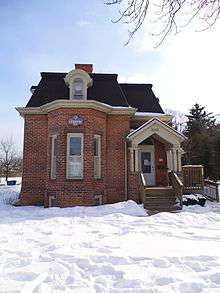Lakeshore Psychiatric Hospital
| Lakeshore Psychiatric Hospital | |
|---|---|
 | |
| Geography | |
| Location | New Toronto, Ontario, Canada |
| Coordinates | 43°35′52″N 79°30′57″W / 43.59778°N 79.51583°WCoordinates: 43°35′52″N 79°30′57″W / 43.59778°N 79.51583°W |
| Organization | |
| Hospital type | psychiatric hospital |
| History | |
| Founded | 1889 |
| Closed | 1979 |
| Links | |
| Lists | Hospitals in Canada |
The Lakeshore Psychiatric Hospital was a psychiatric hospital located in the town of New Toronto, Ontario (now part of the City of Toronto). The hospital grounds now form part of Humber College's Lakeshore Campus.
History
The hospital was built in 1888.[1] as the Mimico Asylum. The doors officially opened on January 21, 1889.[2]
The original idea for the hospital's design of a cottage system was Doctor Joseph Workman[3] who wanted a hospital that would not feel like an institution. The architect for the site was Kivas Tully, who worked with gardener Samuel Matheson, designed the original facility under the supervision of the Superintendent of the Queen Street Asylum, Dr. Daniel K. Clark.[1]
Most of the buildings were built by the patients themselves. Patients also helped with the laundry and tended to the gardens.
The Assembly Hall, now operated by the City of Toronto, was built by the patients in 1898 as a recreation location for the patients, staff, and the public. Sunday worship services were also conducted at the Assembly Hall.[1][4]
The hospital also had its own cemetery, located in the vicinity of Evans Avenue and Horner Avenue. The cemetery is contained the remains of 1,511 former patients of the hospital.[5]
A powerhouse for the site was built in the 1930s to provide heat for the cottages.[6]
After several decades of use, the hospital was renovated starting in 1959 by then superintendent, Doctor H.C Moorehouse.[7]
The site was closed as a hospital on September 1, 1979 with the last 280 patients being transferred to other sites.[8] The decision to close the site was due to its needing to be renovated again.[4] At its height in 1950, the hospital housed 1,391 patients.[9]
In 1988, the site was designated as a historic property.[10]
Films
After the closure of the hospital, the property was used as filming locations, notably being used in the movie Police Academy[11] and its sequels, Police Academy 3: Back in Training and Police Academy 4: Citizens on Patrol'.
Humber College
In 1991, Humber College signed a 99 year lease on the property.[10] The College then started renovating the cottages for use as offices and classrooms. By April 2015, all but the Administration building, known as Building G were renovated. This last cottage underwent restoration and was opened in September 2016 as the Centre for Entrepreneurship.
Today

All of the cottages have been rebuilt by Humber College for their purposes.
In 1999, the former Gatehouse was rebuilt and became a supportive centre for children.[10]
The former powerhouse now has an outdoor skating ring beside it and the building itself has change rooms and washrooms for those using who wish to skate.[12]
The former Superintendent's residence is now part of the Jane Tweed Centre.
The Assembly Hall was renovated in 2000 and opened to the public in 2001. It is now operated by the City of Toronto.[13]
The grounds are now open to the public as a park.
A Tim Hortons occupies the former Carriage House.
A new Welcome Centre was built and opened in September 2016. The Registrar's Office, Health and Career Services have been relocated in this new building.
Name
The hospital was opened as the Mimico Asylum, but changed names several times over the years, becoming the Mimico Hospital for the Insane in 1894, the Mimico Hospital for the Insane in 1911, the Ontario Hospital (Mimico) in 1920, the Ontario Hospital, New Toronto in 1934, before finally becoming the Lakeshore Psychiatric Hospital in 1964.[14]
Gallery
- The Power House, now used for the outdoor skating rink.
 The former Gatehouse.
The former Gatehouse. The former Carriage House, now used by Tim Hortons.
The former Carriage House, now used by Tim Hortons.- The Cricket Oval where patients used to play cricket, with cottages in the background.
- The former Administration Building.
- Building E of Humber College's Lakeshore Campus.
- This is Humber's Building J, the former Cottage 4 of the Hospital.
- Building 'D' of Humber College's Lakeshore Campus. The building used to be part of the Lakeshore Psychiatric Hospital.
- A close-up of some of the details on Building D at Humber College's Lakeshore Campus.
- Building 'I' of Humber College's Lakeshore Campus.
- Building 'H' of Humber College, which was originally Cottage #2 when it was part of the Hospital.
- The entrance to the cemetery for the hospital, located on Evans Ave.
References
- 1 2 3 "Mimico Asylum". New Toronto Historical Society. Retrieved April 2015. Check date values in:
|access-date=(help) - ↑ http://www.asylumbythelake.com/history/
- ↑ http://www.asylumbythelake.com/history/architecture/
- 1 2 http://www.blogto.com/city/2011/04/a_brief_history_of_the_lakeshore_psychiatric_hospital/
- ↑ http://www.asylumbythelake.com/history/cemetery/
- ↑ http://www.asylumbythelake.com/history/architecture/service.html
- ↑ http://www.asylumbythelake.com/history/timeline/1959_1969.html
- ↑ http://www.asylumbythelake.com/history/timeline/1970_1979.html
- ↑ http://www.asylumbythelake.com/history/timeline/1929_1959.html
- 1 2 3 http://www.asylumbythelake.com/history/timeline/1980_1999.html
- ↑ http://www.imdb.com/title/tt0087928/
- ↑ http://www.cityrinks.ca/wiki/wiki.php?n=ColonelSamSmithSkatingTrail.FrontPage
- ↑ http://www1.toronto.ca/wps/portal/contentonly?vgnextoid=360f654c2e110410VgnVCM10000071d60f89RCRD
- ↑ http://www.asylumbythelake.com/
External links
- New Toronto Historical Society: Mimico Asylum
- Asylum by the Lake
- The Assembly Hall
- Police Academy
- A brief history of the Lakeshore Psychiatric Hospital